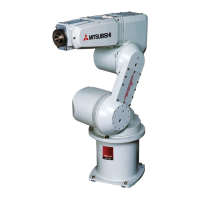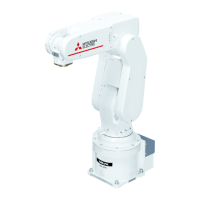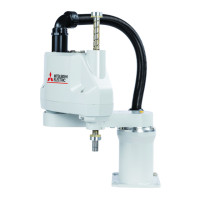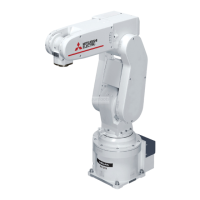
Do you have a question about the Mitsubishi Electric MELFA RV-2SD and is the answer not in the manual?
| Type | Industrial Robot |
|---|---|
| Manufacturer | Mitsubishi Electric |
| Number of Axes | 6 |
| Payload Capacity | 2 kg |
| Repeatability | ±0.01 mm |
| Installation | Floor, Wall, Ceiling |
| Protection class | IP40 |
| Power Supply | 200-240 V AC |
| Category | Robotics |
Details standard and optional structural components included with the robot.
Lists items provided as standard with the robot package.
Describes changes to standard equipment before shipping for special orders.
Information on user-installable components after delivery.
Identifies materials and parts for robot maintenance use.
Explains how to identify the robot model based on its nomenclature.
Breaks down the robot model name components and their meanings.
Shows valid combinations of robot arms and controllers.
Details differences for robots meeting CE marking specifications.
Notes on setting parameter for English display.
Information on instruction manuals provided on CD-ROM.
Lists the components included in the robot's structural equipment.
Details the structural equipment specifically for the robot arm.
Lists the structural equipment related to the robot controller.
Lists all optional equipment and special specifications available.
Provides detailed standard specifications for the robot arm.
Defines key technical specifications related to robot performance.
Defines and explains the robot's pose repeatability accuracy.
Specifies the robot's maximum load capacity and related considerations.
Details the robot arm's protection specifications according to IEC Standards.
Identifies and illustrates the main parts of the robot arm.
Shows the robot's external dimensions and operational movement range.
Covers wiring and piping configurations for robot tooling and hands.
Details wiring and piping for standard equipped hands.
Information on available options for enhancing robot functionality.
Describes options for extending machine cables for flexibility.
Details components to change the robot's operating range.
Information on solenoid valve sets for tooling control.
Specifies cables for hand input signals and confirmation.
Details cables for connecting solenoid valves to robot outputs.
Describes curl tubes used for pneumatic hands.
Lists consumable parts required for robot arm maintenance.
Provides detailed standard specifications for the robot controller.
Lists the controller's technical specifications and features.
Details the controller's protection standards and power supply requirements.
Identifies and labels the components of the robot controller.
Describes the padlock function for securing the power switch.
Provides physical dimensions and installation guidance for the controller.
Shows the external physical dimensions of the controller.
Details the required space and clearances for controller installation.
Explains cable entry points and dimensions on the controller.
Describes types of external input and output signals for robot control.
Categorizes external input/output signals (dedicated, general-purpose, hand).
Explains the functions of dedicated input/output signals for robot control.
Details wiring for emergency stop, special stop, and enabling devices.
Provides instructions for connecting external emergency stop switches.
Explains the special stop input function and its wiring.
Describes the function of door switches for safety interlocks.
Explains the use of enabling devices for safe robot operation.
Information on controlling additional axes with the robot.
Details wiring for the additional axis interface connectors.
Explains the AXMC output for synchronizing additional axis servo power.
Overview of available options for robot functionality enhancement.
Details the teaching pendant for robot programming and control.
Information on the interface for robot hand output signals.
Describes the parallel I/O interface for expanding external I/O.
Specifies cables for connecting external devices to parallel I/O.
Details the parallel I/O unit for expanding external inputs/outputs.
Specifies cables for connecting external devices to parallel I/O.
Describes the RS-232 cable for connecting a PC to the controller.
Information on the CC-Link interface for network communication.
Details the extension memory cassette for increasing teaching points.
Information on PC software for robot programming and control.
Highlights key features of the RT ToolBox2 software.
Lists the contents of the printed instruction manuals.
Lists consumable parts for controller maintenance.
Lists available commands for MELFA-BASIC V programming.
Describes important parameters for robot configuration and operation.
Explains the content and purpose of each available instruction manual.
General safety measures for industrial robot operation.
Describes the robot's self-diagnosis functions for safe operation.
Lists external I/O signals usable for safety protection.
Outlines essential safety measures and rules for robot usage.
Specifies safety measures for automatic robot operation.
Details safety measures required during robot teaching operations.
Outlines safety measures for robot maintenance and inspection.
Provides wiring examples for implementing safety measures.
Advises on suitable installation environments and conditions.
Lists important precautions for handling the robot arm and its components.
Provides a checklist for robot selection and specification discussion.











